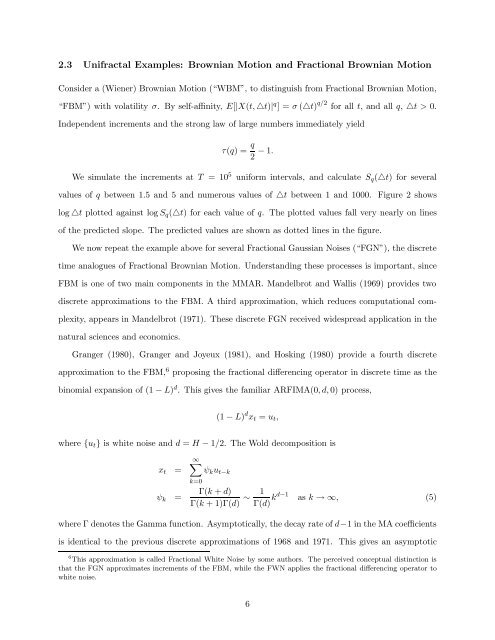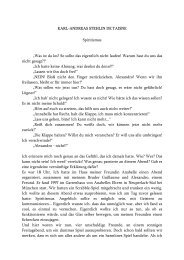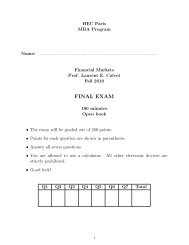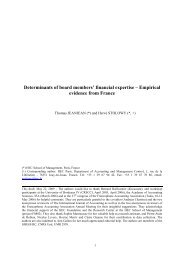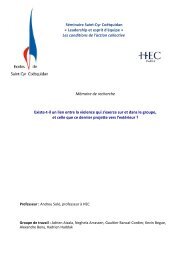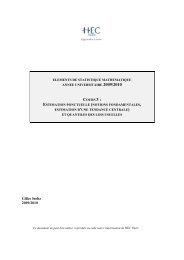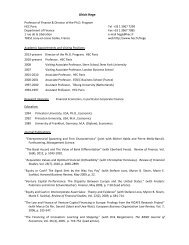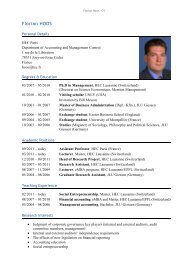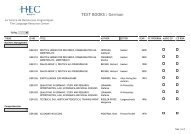Multifractality of US Dollar/Deutsche Mark Exchange Rates - Studies2
Multifractality of US Dollar/Deutsche Mark Exchange Rates - Studies2
Multifractality of US Dollar/Deutsche Mark Exchange Rates - Studies2
You also want an ePaper? Increase the reach of your titles
YUMPU automatically turns print PDFs into web optimized ePapers that Google loves.
2.3 Unifractal Examples: Brownian Motion and Fractional Brownian Motion<br />
Consider a (Wiener) Brownian Motion (“WBM”, to distinguish from Fractional Brownian Motion,<br />
“FBM”) with volatility σ. By self-affinity, E[|X(t, △t)| q ]=σ (△t) q/2 for all t, andallq, △t >0.<br />
Independent increments and the strong law <strong>of</strong> large numbers immediately yield<br />
τ(q) = q<br />
− 1.<br />
2<br />
We simulate the increments at T =10 5 uniform intervals, and calculate Sq(△t) for several<br />
values <strong>of</strong> q between 1.5 and 5 and numerous values <strong>of</strong> △t between 1 and 1000. Figure 2 shows<br />
log △t plotted against log Sq(△t) foreachvalue<strong>of</strong>q. The plotted values fall very nearly on lines<br />
<strong>of</strong> the predicted slope. The predicted values are shown as dotted lines in the figure.<br />
We now repeat the example above for several Fractional Gaussian Noises (“FGN”), the discrete<br />
time analogues <strong>of</strong> Fractional Brownian Motion. Understanding these processes is important, since<br />
FBM is one <strong>of</strong> two main components in the MMAR. Mandelbrot and Wallis (1969) provides two<br />
discrete approximations to the FBM. A third approximation, which reduces computational com-<br />
plexity, appears in Mandelbrot (1971). These discrete FGN received widespread application in the<br />
natural sciences and economics.<br />
Granger (1980), Granger and Joyeux (1981), and Hosking (1980) provide a fourth discrete<br />
approximation to the FBM, 6 proposing the fractional differencing operator in discrete time as the<br />
binomial expansion <strong>of</strong> (1 − L) d . This gives the familiar ARFIMA(0,d,0) process,<br />
(1 − L) d xt = ut,<br />
where {ut} is white noise and d = H − 1/2. The Wold decomposition is<br />
xt =<br />
ψk =<br />
∞<br />
k=0<br />
ψkut−k<br />
Γ(k + d) 1<br />
∼<br />
Γ(k +1)Γ(d) Γ(d) kd−1<br />
as k →∞, (5)<br />
where Γ denotes the Gamma function. Asymptotically, the decay rate <strong>of</strong> d−1 in the MA coefficients<br />
is identical to the previous discrete approximations <strong>of</strong> 1968 and 1971. This gives an asymptotic<br />
6 This approximation is called Fractional White Noise by some authors. The perceived conceptual distinction is<br />
that the FGN approximates increments <strong>of</strong> the FBM, while the FWN applies the fractional differencing operator to<br />
white noise.<br />
6


